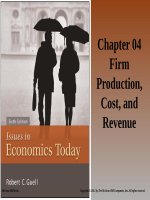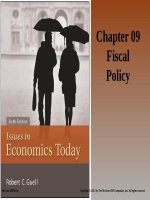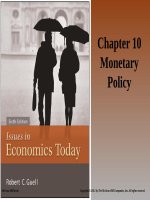Isues in economics today 6th by guell chapter11
Bạn đang xem bản rút gọn của tài liệu. Xem và tải ngay bản đầy đủ của tài liệu tại đây (503.64 KB, 19 trang )
Chapter 11
Federal
Spending
McGraw-Hill/Irwin
Copyright © 2012 by The McGraw-Hill Companies, Inc. All rights reserved.
Chapter Outline
• A Primer on the Constitution
and Spending Money
• Using our Understanding of
Opportunity Cost
• Using our Understanding of
Marginal Analysis
• Budgeting for the Future
McGraw-Hill/Irwin
©2012 The McGraw-Hill Companies, All Rights Reserved
11-2
1-2
Federal Spending as a
Percentage of GDP
McGraw-Hill/Irwin
©2012 The McGraw-Hill Companies, All Rights Reserved
11-3
1-3
The Budget Process
• “No money shall be drawn from the treasury, but
in consequence of appropriations made by law;..”
• Both houses of Congress must pass identical bills
• President must sign or have veto overridden
• President sends Congress a proposed budget
• Congress passes its version of the budget (the
president does not have to sign or veto)
• Congress passes Appropriations Bills
• President signs or vetoes Appropriations Bills
• Tax Law changes must originate in the House of
Representatives
McGraw-Hill/Irwin
©2012 The McGraw-Hill Companies, All Rights Reserved
11-4
1-4
Shenanigans in the Process
• Pork-Barrel spending guided by important
committee chairs.
• Conference committees meet to settle
differences between House and Senate
versions of the appropriations bills.
• Members of conference committees often
add provisions that were not in either bill to
help their constituents.
• Logrolling occurs when Members of
Congress agree to support spending
programs in each other’s districts. This vote
trading increases spending.
McGraw-Hill/Irwin
©2012 The McGraw-Hill Companies, All Rights Reserved
11-5
1-5
Dealing with Disagreements
• When dealing with a disagreement
• Congress can give in to the president
• The president can give in to the
Congress
• They can stalemate and shut the
government down
• They can pass a Continuing Resolution
• Continuing Resolution: a bill passed by
Congress and signed by the president that
allows the government to temporarily
spend money in a fashion identical to the
previous year
McGraw-Hill/Irwin
©2012 The McGraw-Hill Companies, All Rights Reserved
11-6
1-6
Using Opportunity Cost
• Crowding Out: the
opportunity cost of
government spending is that
private spending is reduced
• Money spent on one
government program can not
be spent on another
McGraw-Hill/Irwin
©2012 The McGraw-Hill Companies, All Rights Reserved
11-7
1-7
Mandatory vs. Discretionary
Spending
• Mandatory Spending: those items for
which a previously passed law requires the
money be spent
• Examples (Medicare, Medicaid, Social Security,
variety of welfare programs, interest on the
debt)
• Discretionary Spending is on those items
for which a previous law does not exist.
McGraw-Hill/Irwin
©2012 The McGraw-Hill Companies, All Rights Reserved
11-8
1-8
Spending in FY2011
McGraw-Hill/Irwin
©2012 The McGraw-Hill Companies, All Rights Reserved
11-9
1-9
Mandatory vs. Discretionary
McGraw-Hill/Irwin
©2012 The McGraw-Hill Companies, All Rights Reserved
11-10
1-10
Non Defense Discretionary
Category
2012 in
Billions
Science and Space
Natural Resources and the
Environment
Agriculture
Transportation
Education and Training
Veterans
Justice
McGraw-Hill/Irwin
©2012 The McGraw-Hill Companies, All Rights Reserved
33
37
17
144
102
129
56
11-11
1-11
Federal Spending by Category
McGraw-Hill/Irwin
©2012 The McGraw-Hill Companies, All Rights Reserved
11-12
1-12
Real Health Spending
McGraw-Hill/Irwin
©2012 The McGraw-Hill Companies, All Rights Reserved
11-13
1-13
International Comparisons
of Defense Spending
Country
United States
Defense Spending/GDP
2005
4.0
France
2.4
United Kingdom
2.6
Germany
1.5
Japan
0.8
McGraw-Hill/Irwin
©2012 The McGraw-Hill Companies, All Rights Reserved
11-14
1-14
Using Marginal Analysis
• The question of the size of government
• The optimal size of government is where the
marginal benefit of the last dollar taken from
the private sector and placed in the public
sector equals its marginal cost.
• The question of the distribution of
government
• The optimal distribution of government
spending is where the marginal benefit of
spending on one program equals the
marginal benefit achieved in all other
programs.
McGraw-Hill/Irwin
©2012 The McGraw-Hill Companies, All Rights Reserved
11-15
1-15
Budgeting For the Future
• Baseline Budgeting: using
last year’s budgeted figure to
set this year’s budgeted figure
• Current Services Budgeting:
using an estimate of the costs
of providing the same level of
services next year as last
McGraw-Hill/Irwin
©2012 The McGraw-Hill Companies, All Rights Reserved
11-16
1-16
Obama Stimulus Plan
McGraw-Hill/Irwin
©2012 The McGraw-Hill Companies, All Rights Reserved
11-17
1-17
Obama Stimulus Plan
McGraw-Hill/Irwin
©2012 The McGraw-Hill Companies, All Rights Reserved
11-18
1-18
Obama Stimulus Plan
McGraw-Hill/Irwin
©2012 The McGraw-Hill Companies, All Rights Reserved
11-19
1-19









